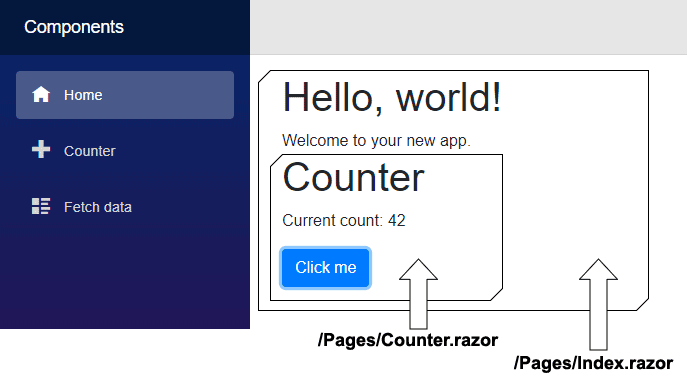All rendered Blazor views descend from the ComponentBase class, this includes Layouts, Pages, and also Components.
A Blazor page is essentially a component with a @page directive that specifies the URL the browser must navigate to in
order for it to be rendered.
In fact, if we compare the generated code for a component and a page there is very little difference.
The following generated source code can be found in obj\Debug\netcoreapp3.0\Razor\Pages\Counter.razor.g.cs for Blazor
3 apps, and in obj\Debug\{DotNetVersion{\generated\Microsoft.NET.Sdk.Razor.SourceGenerators\Microsoft.NET.Sdk.Razor.SourceGenerators.RazorSourceGenerator\Pages_Counter_razor.g.s
in Blazor 5 or later.
Note that after Blazor version 3 these files are no longer automatically written to disk.
To re-enable this feature, edit your csproj file and add the following:
<PropertyGroup>
<EmitCompilerGeneratedFiles>true</EmitCompilerGeneratedFiles>
</PropertyGroup>
namespace MyFirstBlazorApp.Client.Pages
{
[Microsoft.AspNetCore.Components.LayoutAttribute(typeof(MainLayout))]
[Microsoft.AspNetCore.Components.RouteAttribute("/counter")]
public class Counter : Microsoft.AspNetCore.Components.ComponentBase
{
protected override void BuildRenderTree(Microsoft.AspNetCore.Components.RenderTree.RenderTreeBuilder builder)
{
// Code omitted for brevity
}
private int counter = 42;
private void IncrementCounter()
{
counter++;
}
}
}
[Microsoft.AspNetCore.Components.RouteAttribute("/counter")] identifies the URL for the page.
[Microsoft.AspNetCore.Components.LayoutAttribute(typeof(MainLayout))] identifies which layout to use.
In fact, because pages are merely components decorated with additional attributes, if you alter the Pages/Index.razor file of a default Blazor app, it is possible to embed the Counter page as a component.
@page "/"
<h1>Hello, world!</h1>
Welcome to your new app.
<Counter/>

When embedding a page within another page, Blazor treats it as a component.
The LayoutAttribute on the embedded page is ignored because Blazor already has an explicit container - the parent
component that contains it.
